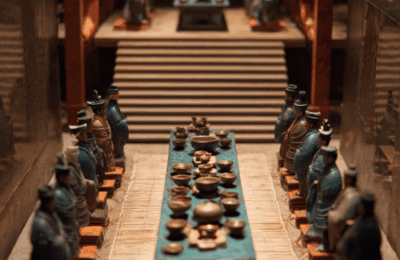《楚国贵族宴会的空间政治学:当权力在席间行走|清华简〈大夫辸速之仪〉〈大夫之大食〉》
清华简《大夫辸速之仪》与《大夫之大食》,揭示了楚国贵族宴会背后极为精密的“空间政治学”。在楚人的世界里,动线不是单纯的行走路径,而是权力的可视化编码:主人必由东阶、宾客必循西阶,沿屏而行、屏外盥洗,每一步都在确认彼此的社会位置。站位同样是秩序的身体化呈现,左楹与右楹、东向与西向,都以极细致的方式划定了责任、身份与权力方向。而当主客入席,宴会更像是一场隐性的治理会议:卷重席、属醢、食三饭、拜三让,甚至侍从在《大夫之大食》中所展现的供应链与后台系统,都体现出楚式社会将“秩序”落实到每一行动细节的能力。楚国贵族的一顿饭,是权力、阶序、空间与身体共同编织的社会系统示范。The Tsinghua bamboo manuscripts Dafu Bingsu zhi Yi and Dafu zhi Dashi reveal the highly sophisticated “spatial politics” embedded in Chu aristocratic banquets. In the Chu worldview, movement routes were not mere physical paths but visualized codes of power: the host ascended the eastern steps, the guest the western; one washed outside the screen, advanced along the screen’s edge, and stood facing east—each step marking and negotiating social position. Standing positions likewise embodied hierarchy: the left and right pillars, the facing directions, and the precise points of stopping and bowing all delineated identity, responsibility, and directionality within the social order. Once seated, the banquet became an implicit governance ritual. Gestures such as rolling the double mat, declining food, taking only “three” or “five” symbolic bites, and the carefully orchestrated sequence of bows were not about eating but about enacting order. Meanwhile, Dafu zhi Dashi details a full backstage system: designated attendants, ascent routes, serving positions, and strict rules governing who may “rotate” roles. A Chu banquet was thus a living demonstration of systemic order—power, hierarchy, space, and the body integrated into a single operational social system.

